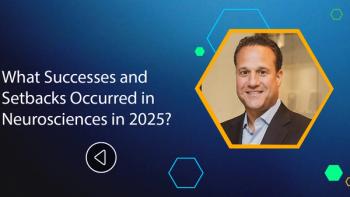
- Pharmaceutical Executive-10-01-2007
- Volume 0
- Issue 0
It's Standards Time
The clinical trials space these days is an alphabet soup of technologies: CTMS (clinical trial management systems); CDM (clinical data management); CDR (clinical data repositories); eCTD (electronic common technical document); and many more. But the technology with the most promise for transforming the way clinical trials are performed (and for driving everyone mad throughout implementation) is EDC-electronic data capture. It's taken more than a decade, but today most big pharma companies-and a fair number of smaller ones-are using some form of EDC in clinical trials. The early adopters might have experienced some growing pains, but the benefits seem to be outweighing the high cost of implementation. Few companies would consider going back to paper-based trials.
The clinical trials space these days is an alphabet soup of technologies: CTMS (clinical trial management systems); CDM (clinical data management); CDR (clinical data repositories); eCTD (electronic common technical document); and many more. But the technology with the most promise for transforming the way clinical trials are performed (and for driving everyone mad throughout implementation) is EDC—electronic data capture. It's taken more than a decade, but today most big pharma companies—and a fair number of smaller ones—are using some form of EDC in clinical trials. The early adopters might have experienced some growing pains, but the benefits seem to be outweighing the high cost of implementation. Few companies would consider going back to paper-based trials.
"Technology is primarily what's driving improved operational efficiency in clinical development today," says Gary Tyson, senior vice president, practice area leader at consulting firm Campbell Alliance. "And EDC is probably the one technology that more companies are embracing for the first time than any other tool."
The key benefits of EDC are well known and hard to ignore: speed and efficiency. With paper trials, it takes, on average, three months to close out after the last subject is accounted for. With an EDC study, the average is closer to three weeks. Unlike paper trials, doctors can review test information moments after it's entered into the system, and data can be queried as it is processed. At the end of the trial, the only difference between the last subject and the middle subject is that it's just the last new piece of data entering the database.
Guiding Light
So why hasn't every pharma company jumped at the chance to implement EDC? One word: standards. There aren't any.
Or, more accurately, there aren't enough. With more than 30 companies offering data-capture systems, not much guidance to date from FDA, and a strong build-it-yourself tradition at many pharma companies, EDC systems vary considerably. And that creates problems: problems in getting the various components of the clinical trials system to talk with each other and problems training and managing doctors and others at the actual research sites. In the past, investigators and staffs have been forced to learn and relearn EDC systems with little consistency in how they operate. That needs to change.
This is not to say there's been no progress on standards. Over the past few years, some key steps have been taken. Most recently, in May, FDA released Computerized Systems Used in Clinical Investigations, its latest guidance for industry on the subject. The 10-page document is general in scope and offers only broad criteria: limiting access to only key users, ensuring that there is an audit trail, using date stamps and security safeguards, properly training users, and the like.
And, of course, the not-for-profit Clinical Data Interchange Standards Consortium (CDISC) is continuing its standards-setting work, with an eye toward providing integrated standards for the entire clinical research process by 2010. Five standards are ready for implementation, most notably the Study Data Tabulation Model (SDTM), which was designed to support the metadata flow from operational database to regulatory submission. CDISC recently announced that it would lead the Clinical Data Acquisition Standards Harmonization (CDASH) project, a project to respond to one of FDA's Critical Path "opportunities" by developing a standard approach to case report forms (CRFs). This project, in conjunction with another CDISC initiative to ease importation of CRF data into electronic medical records, should go a long way toward integrating clinical research and medical practice.
But results are months or years off, and some pharma companies need a quicker, if temporary, solution. Several pharma companies, including Bristol-Meyers Squibb, have formed a consortium with their mutual EDC vendor, Oracle, to find ways to harmonize some of the training for remote sites.
"We recognized that we were having some technical challenges," says Steven Olsen, former EDC business leader at Bristol-Meyers Squibb. "We reached out to three of the other large companies and said, 'Can we talk about our shared investment in this technology?' And we did. We went to Oracle and said, 'Look, we're all struggling in this area. What can you do with us?' And Oracle has now committed to giving its entire client base a new user interface, one that is going to be a much better experience for the site staff about two years earlier than it had planned."
Pharma EDC task groups, coalitions, and open-information-sharing sessions, like those found at the DIA conference, also are making it easier for pharma companies to understand how their systems work and how they affect those who work with the systems, according to industry experts.
"I think standards are going to start to play in over the next five years as pharma companies begin to tap into electronic health records," Olsen says. "Little things like passwords and log-ins can also get confusing when a doctor has to remember them for 20 different technologies running on six different systems."
Doing EDC Right
In the meantime, it's up to individual companies to streamline their electronic processes. According to Campbell Alliance's Tyson, if a company is going to set EDC as a standard, then it has to pick no more than one system and a backup. A company must also select a system that not only meets its needs today but also will meet its needs in the future—across multiple therapeutic areas.
Some tips:
Ease in "Campbell's advice is not to go cold turkey, where you just go from 100 percent paper to 100 percent EDC, but to transition the system over time so that people can get familiar with it," Tyson says. "Then pick one vendor, and stick with it and invest in building a standards library."
Watch the work flow It's important keep in mind that work that was done post-live in a paper environment now has to get done before a trial starts. For example, all databases must be built before the study goes live so that the information from the electronic case report form has somewhere to go.
Decide whether to rent or build Companies need to determine whether they want to work with vendors or create their own EDC tools. The first scenario involves no real commitment and can be used on a study-by-study basis. The vendor builds the system, hosts it in its own EDC environment, and the trial outcomes are nicely packaged for the pharma company at the end of the day. "If you're doing EDC on a study-by-study basis, you could work with three or four different vendors," Tyson says. "It's just done on a one-off, 'who do I feel like working with today?' basis by the various study managers."
Most Big Pharma companies, however, have grown out of the experimental phase. In the last three years, they have realized that if they're going to get real organizational value from EDC, they need to embrace it as a standard in all studies going forward.
Adapting to Change
One area that is really benefiting from EDC is adaptive-trial design. "The whole theory of adaptive-trial design wouldn't work if you didn't have electronic data capture because of the delays associated with getting the data in from a paper-based study," Tyson says.
To Glen de Vries, chief technology officer at EDC provider Medidata, the point of adaptive trials is to allow faster decision making: "With adaptive clinical trials, people are finally saying, 'The processes that we've had to date are not letting us make decisions as quickly as possible. Let's look at new statistical methods. Let's look at new processes,'" he says.
When Wyeth launched its "Learn and Confirm" program, a paradigm shift in how the company performs clinical research, electronic data capture became a natural part of that initiative. Most of Wyeth's new clinical trial initiatives are based on the premise that decisions can be made in real time as the investigators receive the results. "You can't make the changes that you need to make within adaptive trial design if you're not getting data in quickly," says Jane Clarke, senior director for clinical development operation support at Wyeth.
With a paper-based system, it could take Wyeth up to a month or two to recover data from the investigative site and transcribe it into a database. With its new EDC system, the investigator puts the data into the system, and it's available for review back at Wyeth within the time it takes for the system to refresh.
In the two years since full EDC rollout, Wyeth has increased EDC implementation in its clinical trials from 9 percent to 95 percent, which it is now consistently maintaining.
Wyeth didn't go the vendor route. Instead, it developed its own application, custom built for the company. "[When we launched the program], we were not implementing applications at the speed that our management wanted," Clarke says. "I know many companies that started using EDC and then lost their way. I even know some companies that had gone back to paper. I didn't want to do that to Wyeth."
So the company decided on a staged approach to implementation. Stage one was intended mostly to get everyone comfortable with using the system as a standard of practice. The second and current stages were aimed to ensure that Wyeth has the most effective business processes and the most effective tools.
Remote Control
Most major pharmas are still struggling to support the staffs at remote research sites. The big question is: How do you get your investigators as comfortable with EDC as they were with paper?
One thing is certain: It will take time. BMS, for example, has been electronically capturing data on all new trials for the better part of five years. But because trials are long and new projects relatively scarce even in the best of times, only about 35 percent of BMS's current trials use EDC, and fewer than half of the protocol managers had ever touched one, explains Olsen. So while, on the one hand, the company says it has fully implemented EDC, key roles in the organization have yet to work on an EDC study or are still working on their first one.
"For big clinical trials, there's a long planning period from the time a trial goes through protocol concept to the time it gets to the first patient," Olsen says. "If we kicked off a study today, we realistically aren't going to get to the first patient until sometime next year. As we're ramping up and moving from pilot stage to 25 percent EDC, to 50 percent EDC, we have to remember that we still have a lot of studies that are legacy paper systems.
"One of my learning specialists said to me, 'If you think about adult learning behaviors, it's see one, do one, teach one,'" Olsen says. "If you take that concept that you've got to run something three times before you're really comfortable with it, it may be six to nine years before you're really as comfortable with EDC as you were with paper clinical trials."
Even with the long learning curve, Olsen says his teams truly appreciate EDC. Benefits include ready access to data, and real-time data cleanup as the studies move along. Because of automated query systems that are built into EDC technologies, the company is seeing a tremendous reduction in the number of queries and discrepancies that must be handled internally.
"Will we get to glossy, high-level ROI numbers in the immediate future?" Olsen asks. "Probably not. Will we see them in four or five years? Definitely yes."
Patient Reported Outcomes
One "adjacent technology" that is gaining momentum is electronic patient-reported outcomes (ePRO). These systems can be used by clinical trials patients to make comments, score themselves on symptoms, and the like. Wyeth is giving patients PDA-style computers on which they can enter data electronically. The information is uploaded from the PDAs to the company's central EDC system, which in this case is a Web-based program that can be accessed by any trained employee at any time.
"We can review the data within 24 hours of patient visit," says Wyeth's Clarke.
According to contract research organization Quintiles, FDA is encouraging the use of ePRO in middle- and late-stage trials to get instant feedback from patients as they use a treatment.
Some companies are still apprehensive about giving new technology to patients. BMS is looking at ePRO but hasn't made any overtures toward adopting it. "As a result, because many of our competitors are using those types of technologies, some of our trials suffer because we're collecting that same information still on paper," Olsen says. "And it's a struggle, because it makes us look different and it makes us perhaps not as desirable as a clinical trial organization."
Stepping Up
Until the standardization of clinical trials is complete, a big challenge for most companies will be choosing how much technology to bring to an individual project.
As companies start moving up the technology ladder, they can add and in workflow components that are consistent with what happens in a clinical trial.
For example, an average EDC system features a menu system based on the study structure. Each visit gets a page, and there are sub-pages within each visit for standard tasks that happen in every clinical trial. These can include source-document verification, investigator electronic signatures, electronic query management, and so forth.
Because the majority of clinical trials are still done on paper (approximately 70 percent according to eTrials), some companies are finding it easiest to start out with projects that mix paper and EDC.
"Companies can get a simple, bare-bones data-input system, which is basically almost anything you would see on the Web where data is input," explains Rick Piazza, vice president of product strategy at eTrials. "If a company starts out using it as an input system for paper, they're starting to build their expertise with the system. They're starting to get comfortable with the system, and it's a good way to lower that learning curve."
There are also cases when it is still more efficient to do paper—for example, a postmarketing study where a company is studying very few patients and might collect only one piece of data every month over the course of three or five years.
"It might not make sense to build an entire Web site, train a set of staff at the site for a database they'll access only once a month for a little bit of data—because no one's really in a rush to see that data anyway," Tyson says.
But even if you start out with a simple front-end system, says Piazza, don't neglect the back end. "Every EDC system should also have robust reporting," he says. "That's a key requirement these days that every sponsor wants. They want to be able to produce reports of the live, real-time data, and query those reports. That's something you can't do on paper, and a lot of systems didn't do it even five years ago."
Articles in this issue
about 18 years ago
Some Alzheimer's Patients Left Behindabout 18 years ago
Hits Like a BRICabout 18 years ago
What's Worrying Sales?about 18 years ago
Medicare Part D Puts the Focus on Pricesabout 18 years ago
R&D Innovation: An Answer to Cancerabout 18 years ago
Radio Activeabout 18 years ago
Shade-Tree Syndromeabout 18 years ago
Lifecycle: End Gameabout 18 years ago
Waiting for Reform. Major Reformabout 18 years ago
The Wiki IncidentNewsletter
Lead with insight with the Pharmaceutical Executive newsletter, featuring strategic analysis, leadership trends, and market intelligence for biopharma decision-makers.





